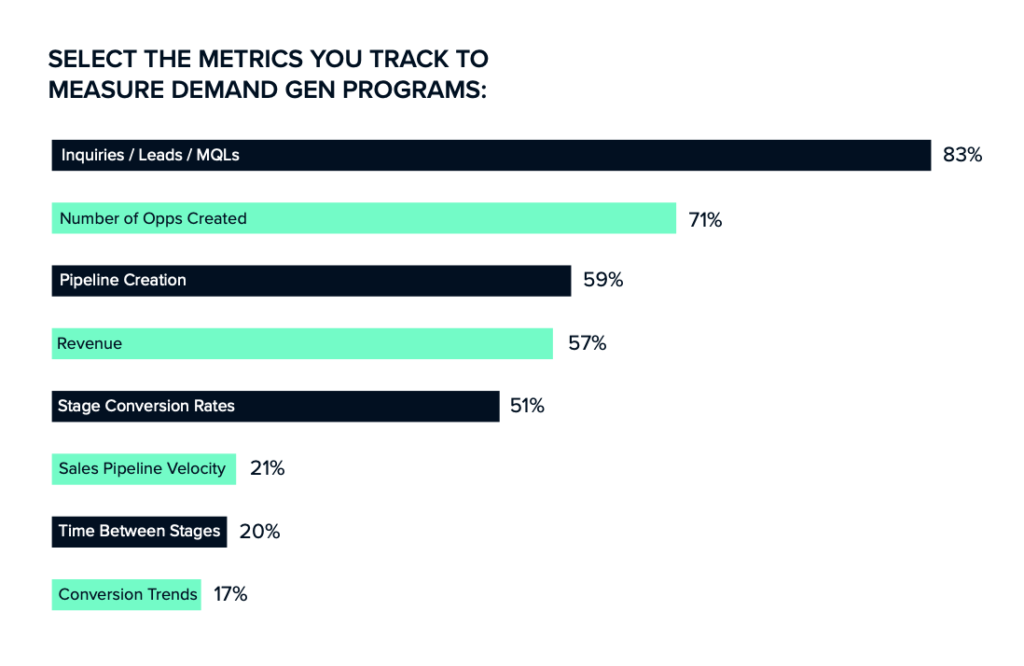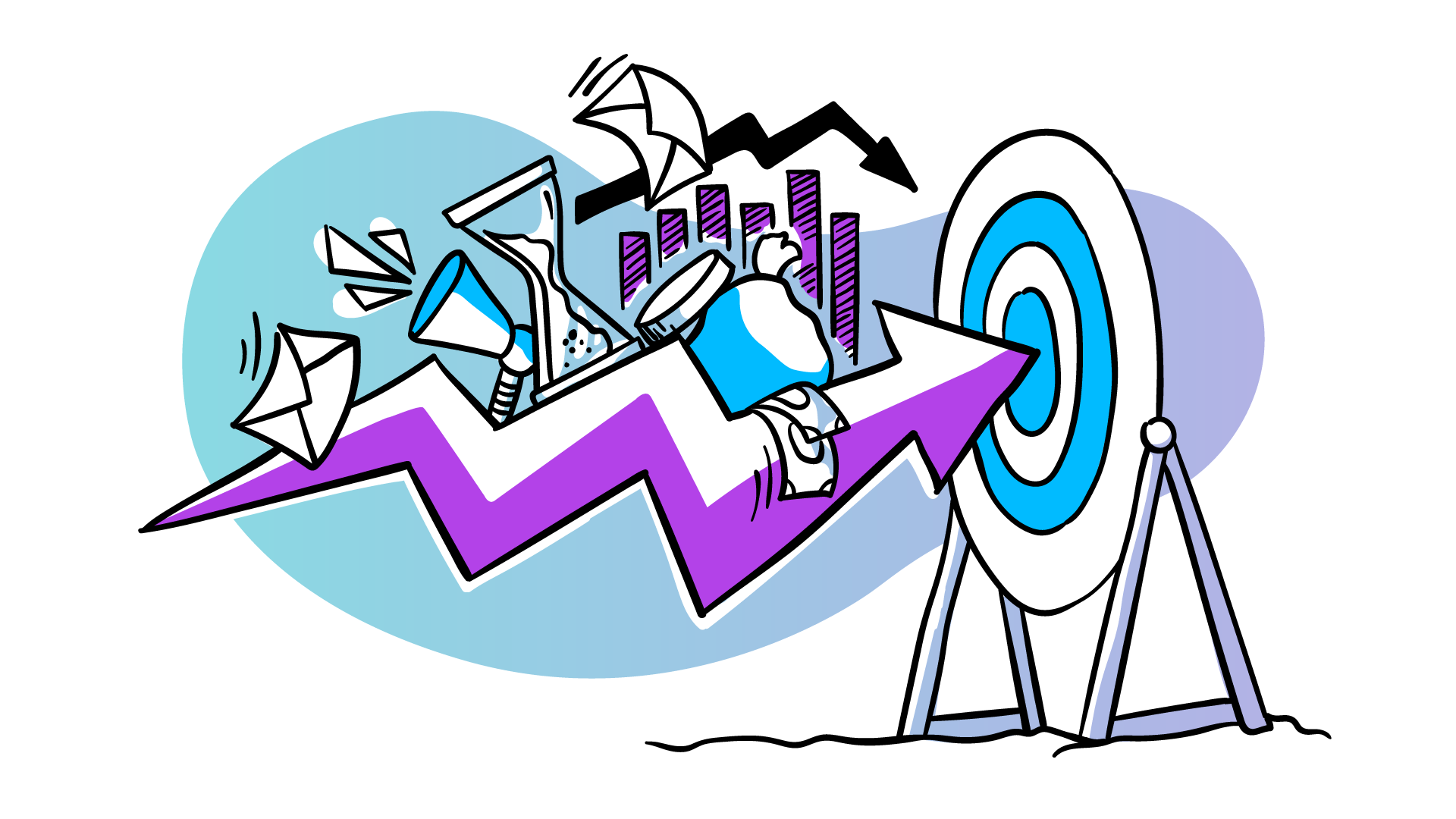I was head of marketing for a rapidly growing company. We were growing our leads (free software trials) by double digits every month. Content marketing was working. We were scaling paid advertising successfully. In the marketing team, we didn’t quite high-five each other every day but it was close.
In hindsight though, I was failing pretty badly.
How can you be growing leads aggressively and failing at the same time? By looking at marketing results in isolation from company revenue results. By not evolving your standards. By ignoring that in B2B the only suitable kind of marketing is revenue marketing.
Important context: I’m mostly talking about organizations where sales and marketing have to work together. As opposed to companies where 90% of the result is generated by either sales or marketing by itself, for example, transactional e-commerce on one extreme or government security contracts on the other.
I’ve noticed that most companies go through five stages as they’re ramping up revenues. Some companies skip stages and not everyone graduates to the final one. But it’s always useful to know which stage you’re at in order to know what new habits, tools, and processes to look out for.
Stage 1. Getting from zero leads to first leads.
In the earliest stage of the evolution, salespeople need leads to speak to, and so marketing sets out to, well, generate leads.
A form and/or chatbot is added to the website.
Proverbial rolodexes are given a shake to find people to send an email campaign to.
Ad campaigns are started on Google, LinkedIn, or one of the other major digital platforms.
Leads are generated. Not everything is working right away but at least there’s data coming in that lets you learn and optimize.
How to get to the next stage?
- Read about different lead generation strategies to find the ones that work for you.
Stage 2. Putting lead generation “on autopilot”
When you’re just starting out, there is probably a lot of manual work involved to make sure that campaigns get executed and measured in some shape or form, and that someone would follow up the leads. There’s room to improve productivity, in other words.
Note that in many situations, it’s actually wise to first go through the manual work, because you’ll learn a lot in the process. However, in order to evolve to the next stage, don’t get stuck doing the manual work and automate what you can after you’ve learned your lessons.
You’ll want to track your time to see where you’re losing most of it, or even set up a time-per-lead KPI you could monitor across different channels.
And you’ll definitely want to minimize the number of spreadsheets you import and export between different systems. Not only is this a massive time sink and generator of human errors, but this is also increasingly a privacy regulation headache.
How to get to the next stage?
- Automate your email marketing.
- Delegate or outsource campaign management.
- Invest into integrating various tools.
- Track time-per-lead in addition to cost-per-lead.
Brazen pitch: if you lose many hours to connecting your sales and marketing data, use our App connector to connect your CRM deeply and easily with marketing tools like Mailchimp, ActiveCampaign, Wix Forms, Unbounce, and others.
Stage 3. Breaking down the sales and marketing silos of “demand generation”
You’re generating leads (or “generating demand” as they say in some circles) and you’ve gotten rid of the biggest time sinks by automating. Life is pretty good.
That is until someone from sales says that marketing is generating poor quality leads, or someone from marketing finds their work is not appreciated. The ROI of your campaigns might be low or simply not known. Sales and marketing work in silos.
Many B2B companies get stuck in this phase. I was stuck in this phase in the example I brought at the start of the post. I felt that we at marketing were doing a great job but I didn’t show enough initiative to maximize the revenue benefits of the leads we were driving.
As Yaagneshwaran Ganesh describes this stage in The Revenue Marketing Book:
“Sales teams don’t see value in the leads shared by the marketing teams. Marketing teams feel that sales teams don’t give a damn about the leads shared with them.”
How to get to the next stage?
- Connect sales and marketing data.
- Calculate the true ROI of your main campaigns and programs.
- Agree on qualified lead definitions.
- Set up feedback loops between sales and marketing with integrations and tools like lead scoring.
Stage 4. Scaling predictably and avoiding “surprises”.
In the fourth stage, things are definitely working, at least most of the time. Marketing has established viable ways of generating high-quality leads, collaboration with sales is adequate and the focus is on delivering these at an increasing scale.
However, your results are not always repeatable or predictable. Every now and then, there are unpleasant surprises. You may miss monthly and quarterly goals. Or you may realize you’re not on the right track when you’re already half-way through the period, and then it’s too late to correct the course.

The right thing at this stage is to establish leading indicators among your KPI’s in addition to the traditional metrics of MQLs, SQLs, and revenue. You’ll want to “peek into the future” with your metrics.
For example, if you’re relying on Google Ads to generate your leads you’ll want to keep a close eye on cost-per-click and/or cost-per-lead for your dominant campaigns. Because if cost-per-click increases notably then, all things equal, your sales cost is about to go up.
Or, if you know that different lead sources or geographies convert to revenue at different rates, you’ll want to monitor leads per source or geo in addition to an overall number of leads. This way you’ll identify any bad surprises right when they happen, not after the duration of your usual sales cycle has passed.
How to get to the next stage?
- Set up “leading indicators” for your key marketing programs and campaigns.
- Set up dashboards both for leading and lagging KPIs.
Stage 5. True revenue marketing with happy sales and marketing people.
At stage 5, the business is hitting growth goals. The revenue impact from marketing is repeatable, predictable, and scalable. Marketing has established itself as a core business function and works in close alignment with sales.
Is there anywhere further to go?
I think so. The biggest asset of your business is not your process playbook, martech stack or dashboard. It’s your people.
Achieving big goals usually causes stress and tensions. The better your revenue marketing is working, the bigger the risk of people burning out and/or leaving the company.
Some of this you can monitor with employee NPS and retention rate benchmarks.
But a lot of success in people issues comes down to the unquantifiable: paying attention, active listening and taking appropriate action.
Where to go from here?
- Monitor employee NPS in your sales and marketing teams.
- Do the right thing(s) in people management.
The aim is not to get to the last phase ASAP, it is to make progress.
According to a recent study, most B2B marketers are “activity marketers” or “pipeline marketers”, which means they are in stages 1-3 of the evolution. As revenue accountability continues to grow, more and more marketers will need to evolve to stages 4 and 5.
But the aim is not to get to a particular stage or to leave one. The aim, in addition to growing revenue, is to make progress.
Regardless of where you are today, the real question is: what one thing can you improve today to become a better revenue marketer?
I hope this post helped to see where to look.



